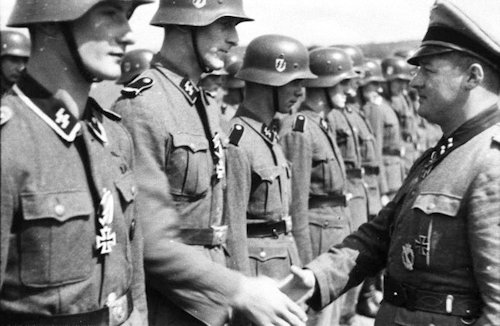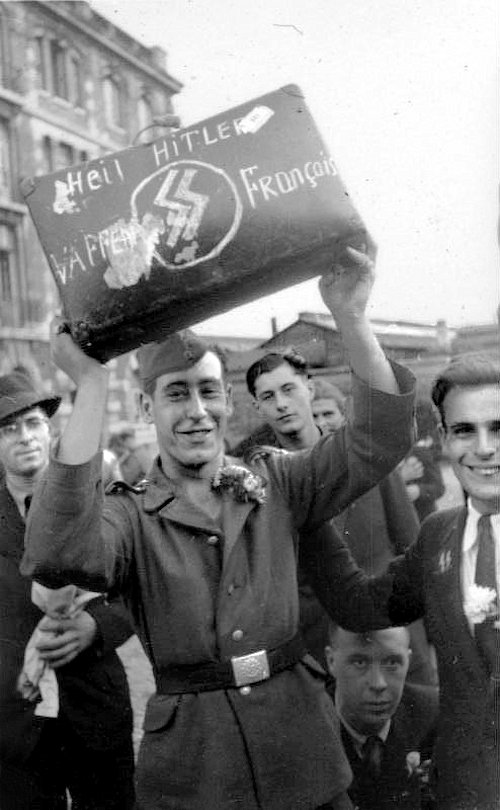The SS were formed in 1925 by recruiting members of the SA who until 1926 were part of Adolf Hitler's personal guard and supervised party rallies. On January 6, 1929, Hitler appointed Heinrich Himmler as head of the SS. At that time the staff was only 280 men.
With Hitler's approval, Himmler expanded the ranks of the SS and by the end of 1932 they already had 52.000 members. After just one more year they had reached over 209.000 men; later SS of other nations would also be enlisted, those of Eastern Europe (v.articolo) formed an important nucleus. In this article we mention the Western ones and report facts from a seemingly distant past that we hope can trigger a series of reflections on today's times, the study of the SS can open the doors to understanding events of the third millennium.
Western Europe SS List
La 5ª SS-Panzerdivision "Wiking" (photo below right) was born in January 1941 and was made up of Norwegian, Danish, Dutch, Finnish elements and to a lesser extent other nationalities. It was employed in Russia, Czechoslovakia, Poland, Hungary and Germany before capitulating on May 8, 1945.
He immediately distinguished himself for the audacity and dexterity of his men, but was overwhelmed at the Russian front by the advance of the Soviets and by the winter that caught her unprepared, even though most of the fighters were of Nordic origin.
The divisional insignia is identical to the runic symbol of ancient Norse origin, used as a symbol of the Thule Society.
L'11 SS-Freiwilligen-Panzergrenadier-Division Nordland was a mechanized division formed from July 1943 by volunteers from Scandinavia and Denmark, as well as shares from the Netherlands.
The division was trained in anti-partisan Croatia and was then sent to Curlandia where it was engaged in very tough fighting at Leningrad; there Nordland, arrived at the front near the Russian city but had to fall back to Narva (Estonia) engaging in a bloody battle that would go down in history with the name of "battle of the European SS", since most of the defenders were Europeans various ethnic groups.
The flagship of the division was the "Explorers Department".
La 23 SS Freiwilligen-Panzer-Grenadier-Division "Nederland" was born in the autumn of 1943 and was made up of Dutch fighters.
We celebrate the assault against Leningrad that should have been the coup de grace for the defenders. The launch of the offensive, the August 14, was preceded by a Soviet counter-offensive that turned the operation into a complete failure with many units removed from the attack to try to stop the counter-offensive.

After this failure the division was forced to fall back and was assigned to other missions that saw it defend itself always with honor until the capitulation in 1945; after the war the survivors were tried in the Netherlands, receiving numerous death sentences.
La 27 SS-Freiwilligen-Grenadier-Division "Langemarck" was born in July of 1943 and was formed by Flemish and Finnish volunteers; it was used in Czechoslovakia, Germany, Ukraine and Poland.
It consisted of three regiments of grenadiers, an artillery regiment and other departments; surrendered like many other divisions the 8 may 1945, was an example of what were the SS since they coexisted to the orders of German combatants from non-neighboring nations and having other affinities if not military belief.
La 28. SS-Freiwilligen-Grenadier-Division der SS "Wallonien" it was a military unit made up of Walloon, French and Spanish volunteers; in May 1942, the Walloons found themselves in the Russian Donetz region. In June 1943 the legion entered the Waffen SS becoming the Sturmbrigade Wallonien. Between December 1943 and February 1944 she found herself involved in bloody battles in Ukraine, suffering a huge number of casualties in Cherkasy.
The 3 May 1945 was surrendered, consisting of three regiments of grenadiers and one of artillery.
La 33. Waffen-Grenadier-Division der SS Charlemagne (französische Nr. 1) was created in the summer of 1943 and was active since 1944, was made up of French volunteers of national socialist ideology and war prisoners who had decided to fight for the invader.
The strenuous defense of the city of Berlin of a small handful of soldiers of the Charlemagne that were asserted even if pressed by the massive attacks of the Russians before the capitulation has passed into history; What prompted the French to fight so hard against the invaders? The answer in the words of Christian de la Maziere, a volunteer survivor of the Charlemagne:

"I grew up in a right-wing family, before the war I read newspapers full of alarming news about the atrocities committed by the Communists of the Soviet Union and in Spain; I was also infected by the racial intolerance widespread at that time ”.
La 34.SS-Freiwilligen Grenadier Division Landstorm Nederland It was born in the spring of 1943, and was composed of only Dutch elements that defended local bridges and railways; This division was first framed by officers of the German police and then returned to the control of the Waffen-SS, strenuously fought the first division of British paratroopers in the battle of Arnhem and later the Canadian troops until the capitulation in the 1945. It consisted of two regiments of grenadiers and one of artillery.
To mention also the Schnelles SS-Schutzen-Regiment "Langemark" (Flemish volunteers)
Il Freikorps Danmark (Danish volunteers)
Il Freiwilligen-Legion Flandern (Flemish volunteers, Dutch, Danish)
Il Freiwilligen-Legion "Niederlande" (Dutch volunteers)
La SS Freiwilligen-Legion "Norwegen" (Norwegian volunteers)
Il Finnisches Freiwilligen-Battaillon der Wafen SS (Finnish volunteers)
La Indische Legion (Indian volunteers from Subhas Chandra Bose)
Il British Freikorps made up of about twenty British volunteers, the small number of this brigade should not be deceived since, as early as March of the 1888, a London Great Britain Street building was built at Great Queen Street,Order of Golden Dawn in the outer (External Order of the Golden Dawn), an association that directly depended on Nuremberg and proselytized with the establishment of other independent lodges in British territory and also in Paris.
It included Williams Yeats (future Nobel Prize for literature), Gerald Kelly (president of the Royal Academy), Bram Stoker (the author of Dracula) and many other personalities.
These continental and overseas associations constituted the substratum upon which the National Socialist culture was subsequently engaged in later years, the great war postponed only a path that was already in the process and that it came to the European SS army, whose ideology is infamous symbolisms, ideals and methodologies that can be traced back to this historical period.
The SS did not arise from one day to the next, in the previous years they laid the foundations for their birth; in the 1933 the German publisher Ulrich Fleischhauer on solicitation of Nazis from various nations of central Europe creates a "Technical Assistance Office" having as its purpose the foundation of an "International of the nationalists", the idea pleased the hierarchs to the point that the Ministry of Propaganda andAussenpolitschesamt, the foreign relations office of the Nazi party, financed on the World Service whose projects are represented by some documents:
"The world service fights for the understanding between peoples and for the maintenance of peace among civilized nations; in fact only peace is the pledge of true civilization and true humanity, the pledge of the superior development of mankind, source of happiness for all peoples. United in this struggle, patriots from all over the world, ready to make every sacrifice, organized themselves to allow the World Service to carry out its cultural work and this in complete independence from any government ".
It reads again: "... It is also desirable for the news we publish to pass to the press oriented of all countries."
These periodicals were published in eighteen languages during the war years and the "Service" also organized international conferences in the strictest secrecy, with the aim of promoting the propaganda carried out by the Third Reich on a global scale with the aim of influencing the media of various countries.
All this is necessary to explain what was upstream of Waffen-SS who worked in the battlefields, the warriors who fought for a united Europe and subjugated to Germany were the tip of an iceberg, behind there were years and years of ideological preparation and ramifications in every European country, but Hitler's defeat wiped out these intentions, or perhaps, according to some scholars, only deferred them.
According to a rich array of historians, the SS survivors laid the foundation for silent continuation of the teutonic projects of continental leadership, but this is not the place to discuss them.
(References: The swastika in the darkness, Editions Il Foglio 2006, Illustrated History January 1970 Arnoldo Mondadori Editore)












